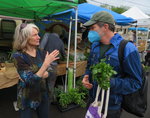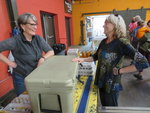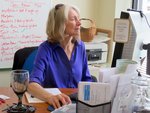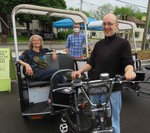



For the past 23 years, Allen Neighborhood Center executive director Joan Nelson has bent every ear in reach about the latest great thing on Lansing’s east side. She always closed with a teaser: “Now we’re working on something really great, but I can’t tell you yet.”
It was never hype. In a few months, or a couple of years, everyone would find out.
A trashy, neglected park would come back to life. A tiny farmers market would grow into a weekly community event and a model for dozens of farmers markets across the state. Homes lost to flooding would morph into urban farms.
Last month, readers across the nation found out about the east side’s latest “really great” thing on the front page of The New York Times. Allen Place, a city block of do-gooding synergy, with a community health clinic and 20 mixed-rate apartments that are already full, powered by a solar array and festooned with a big, bold mural by artist Brian Whitfield, is now a reality on humble Kalamazoo Street, the un-glamorous shadow corridor a few blocks south of Michigan Avenue.
With the capstone of over 20 years of work settling into place, Nelson, 73, stepping down as ANC director this summer. Her departure is not just a chance to recite her many achievements.
Community leaders blaze into view and burn out left and right. Nelson’s quiet effectiveness and staying power demand that we open the book of her life and draw a bone-deep lesson with more relevance than ever.
Another longtime Lansing stalwart, Eric Schertzing, served as Ingham County treasurer and chaired its pioneering land bank for 21 years until he left the post this year. He and Nelson toiled in many of the same community-scaled vineyards, but Schertzing is unequivocal in his “worship” of Nelson.
“Joan is my superior in this work,” Schertzing declared. “She labored as hard or harder than I did, for longer, and her compensation was less. I’m not sure I would do half of what Joan has done for twice the money.”
Nelson began her life of activism and advocacy in the early 1970s, amid war, poverty, racial division and environmental disaster, speaking out against the Vietnam War and training women in self-defense.
People marvel at her indestructible optimism, but she knows full well that all four horsemen of the apocalypse are circling again, with powerful new allies.
She also knows from tragic personal experience that the human condition can be unspeakably bleak.
And yet, if you are biking along Kalamazoo Street, chances are she’ll be there, picking up trash in the right of way, chatting up a passerby, taking a break from poring over the grant proposals, spreadsheets and community surveys that lead to “the next great thing.”
Nelson has a black belt in karate. She knows how to leverage trouble and lift, lift, lift.
Tough Duty
In May 1974, Joan Nelson’s younger brother, David, suffered massive head injuries after being hit by a car while riding a bicycle near the family home in Michigan’s Bay County.
Part of his brain was removed, leaving him unable to move or speak.
There wasn’t much hope for recovery, but after David spent seven months in the hospital, the family couldn’t bear to leave him in a nursing home.
The family decided to try a grueling, long-shot rehabilitation technique that required teams of five volunteers to move David’s limbs and “pattern” various movements, three times a day, for three hours at a time, six days a week.
Insurance didn’t cover the regimen, but other people stepped up in ways that influenced Joan Nelson’s concept of community for the rest of her life.
Both of her parents were pillars of little Bangor Township, about a mile from Bay City State Park. Nelson’s father, Otis, helped develop the township’s recreation program from one small ball field to more than 20 in about 10 years.
Young Joan was already community minded, having spent many summer afternoons helping her mother, Eva, sell potato chips and pop at every ballgame.
“My mom was president of the PTA, a den mother for my brother’s scout troop,” she said.
She admired her parents, but by the mid-’70s, her anti-Vietnam War and feminist activism as a student at MSU put some distance between them.
“I had become somewhat estranged from my folks during all those years of political activism, because they felt very different from me,” she said.
But now it was time to circle the wagons.
To Nelson’s astonishment, some 100 volunteers from the surrounding community stuck with David’s “patterning” regime, day after day, for three years.
“I have a lot of great volunteers at the Allen Neighborhood Center, but I’m pleased when someone stays for a year, or a semester,” she said.
Her mother stayed upbeat and kept the therapy going, scheduling the teams, baking fresh cookies and rolls for the volunteers.
“There were high school teams, teams from the church,” Nelson said. “There were steelworkers in the Wednesday night crew.”
The camaraderie led to unexpected blessings.
“People met one another by being part of the same patterning team and got married,” Nelson said. One couple had a child and made David the honorary godfather.
Every year, Nelson’s parents threw a big “patterner’s picnic” and barbecue.
But David’s progress was slow and painful.
“He learned to crawl, and to turn over, and he spoke a few times — to curse,” Nelson said. “But the damage was so serious.”
David died three years after the accident.
“There was never much hope, but for three years, they kept coming every week,” Nelson said. “That was tough duty. I learned about people’s capacity to care, and to keep giving, even when the prospects were pretty bleak.”
‘Let this song be a warning’
Nelson arrived at MSU at 18, in fall 1967, at the height of the Vietnam War. By the following spring, she was organizing antiwar events on- and off-campus. She found herself mingling with hardhats from Lansing’s Motor Wheel factory at Joe’s Bar, a Quonset hut where workers grabbed a quick lunch.
By then, she was part of a group called the Mother Jones Anti-War Memorial Collective.
More than once, someone put a quarter in the jukebox and Merle Haggard’s voice crooned, “If you don’t love it, leave it. Let this song be a warning.”
“I’d talk to them about the fall of Dien Bien Phu and they could care less,” Nelson said. “They teased me, called me ‘The Politician.’ That time formed me permanently.”
Soon after, she joined a group of women from various antiwar groups to form a women’s liberation “rap group,” not in a musical sense, but in its 1970s sense of blunt talk. Inspired and provoked by the group’s discussions, she trained as a rape counselor with The Listening Ear, but she quickly ran into her own limitations.
“I had no more idea about how to prevent an assault than the women I was counseling,” she said. “I felt really vulne-*rable for a moment.”
The key phrase: “for a moment.” Nelson joined the MSU Karate Club and spent the next 25 years training and teaching in the martial arts.
In 1974, she felt the itch to “get out of Dodge.”
She packed everything she owned into her 1968 Delta 88 Oldsmobile and drove to the Florida Keys, where she did a brief stint on a 26-foot commercial fishing boat known as the “Blue Bathtub.”
A self-educated retired Navy lifer named Bob Eddington took her on as first mate.
“He loved to fish. He went out, no matter the weather,” Nelson recalled.
Often, after a day of fishing, Eddington would duck below decks, swap his dirty hat for a clean one and solemnly return to the bow with a container of human ashes.
“He was the go-to guy for people who wanted their Aunt Tillie’s ashes scattered at sea,” Nelson said. “He took it quite seriously.”
As Captain Bob scattered the ashes, he would say “Vaya con dios” (“Go with God”) or, alternatively, “Que sera sera.”
The art of movement
After her brother died, Nelson earned a master’s degree in exercise physiology. In 1984, she opened Movement Arts at Firehouse No. 4, the oldest firehouse still standing in Lansing, at the corner of Bingham and Prospect streets.
There, Nelson taught martial arts and formed a club of about 50 people. There were groups doing tai chi, African and Chinese dance, Pilobolus workshops and meditation classes.
“I loved every piece of it,’ she said. “I’ve always loved movement. I still know my tap routines from when I was 5 years old.”
But Movement Arts was a labor of love that took over 70 hours of work to keep afloat.
She created a consulting firm, Safesense, and began teaching workplace violence prevention, mostly for people whose jobs put them at some risk — field agents for the state Natural Resources Department, protective service workers, prison nurses.
She kept the firm going until 1997, working out of her home, spending time with her son, Peter.
Nelson said she has had “three long term partnerships/relationships” in her life.
“One of them involved marriage to the father of my son, Peter,” she said. She is not married now.
While Safesense involved traveling across the state tow work with clients for about half the week, it let her spend time with Peter, a creative soul who is now an accomplished jazz musician.
“He could come up and show me costumes he had designed, pictures he had painted,” Nelson recalled.
By 1997, she was burning out on anti-violence work and ready to expand her purview.
Her thoughts drifted back to 1971, when, fresh out of college, she worked as a community organizer in the federally funded Model Cities program. Model Cities ended in 1974, and the results are debated to this day, but Nelson learned a lot from its neighborhood approach. Instead of imposing top-down measures like bulldozing “blighted” neighborhoods and putting up massive housing projects, a policy board packed with neighborhood representatives oversaw the distribution of Model Cities money.
“The first conversations about public transportation that led to CATA, solid waste pickup, community health initiatives and many other things came out of Model Cities,” Nelson said.
Said Schertzing: “The Joan Nelson who was able to accomplish so much these past 20 years, the Joan Nelson we know and love, goes back to Model Cities. That’s the culmination of 50 years of training and learning and doing. These things are complex and they are difficult to do well.”
Nelson’s interests were already expanding from self-defense to the link between movement and health and beyond. Her interest was caught by a new program at Sparrow Hospital, the Healthy Communities Initiative. The program aligned with the World Health Organization’s expanding definition of “health,” taking in housing, income, education and other factors.
“I loved that broad definition of community health,” she said.
Ten hours a week ballooned into a full-time job.
She knew they were onto something when a “community health summit” in March 2000 drew 300 people to Eastern High School. Teams of “health navigators” and “housing ambassadors” were assembled to help residents navigate health and housing issues on the east side — “neighborhood center without walls,” Nelson called it.
The March 200 summit produced a manifesto of sorts, “Growing in Community: A Plan for Lansing’s East Side,” aka “the Heinz Plan,” because it listed 57 strategies. The plan became the blueprint for the Allen Neighborhood Center.
Bruce Bragg, longtime director of the Ingham County Health Department, got funding for a brick-and-mortar headquarters enabled the eastside community summits to evolve into the Allen Neighborhood Center, Nelson’s base of operations for over 20 years.
One thing builds on another
The original “gang” of four members of the Allen Neighborhood Center’s Board of Directors were Nelson, Rick Kibbey, former military nurse Diane Harte and local florist and longtime local organizer Ruth Leyrer.
Nelson had known Kibbey since her days at MSU, when she first saw him leaving the Administration Building after an antiwar protest. Kibbey went on to chair the Lansing Parks board.
It didn’t take long for the board to appreciate Nelson’s potential as a community leader.
“I was kicked off the board and asked to apply for the position of director,” Nelson said.
She lost no time and set immediately to taking the pulse of the neighborhood.
When Nelson and her staff fanned out into the neighborhood, they found that 29 percent of households ran out of food money before the end of the month. Immediately, Nelson focused the center’s attention on food, which is still the nucleus of its proliferating programs. The first step was setting up a food pantry that still distributes about 1,000 pounds of baked goods and produce a week.
But Nelson is always looking for ways to build capacity, not just do triage. She envisioned a neighborhood farmers market, with the goal of bringing fresh, locally grown, nutrient-dense food to the east side.
“More than any other program we did, we knew it had to be a happening, a part of developing the identity of the east side,” Nelson said.
When market started in 2004, there were only two others, the downtown Lansing City Market and the Meridian Farmers Market, both of them municipally owned. A 10-week pilot program with four farmers, all women, was such a success that the program went to a full May-to-September schedule the following year.
The last thing Nelson wanted to do was to drop a boutique market into the struggling east side, where well-off visitors picked up baby arugula while sipping lattes.
“We knew all the foodies would love a farmers market,” Nelson said. “Who wouldn’t? But we wanted to make sure the market was for everybody in the neighborhood.” In the days before wi-fi, Nelson and her staff strung wires over the building to set up an EBT machine in the parking lot. Now over 26 markets in mid-Michigan, and 70 across the state, take food stamps.
“Our little market does about $300,000 of business a year,” Nelson said. ‘That’s the power of a neighborhood farmers market.”
It was also clear to Nelson that real food security would mean growing food in the neighborhood.
Working with local residents and officials like Schertzing and Ingham County Drain Commissioner Pat Lindemann, Nelson encouraged the conversion of acres of land into urban farms on the flood-prone east side.
“Urbandale is in the floodplain,” Lindemann said. “Rather than lose that neighborhood to a flooding condition, Joan attempts to save it, and I think that’s wonderful. She’s an advocate after my own heart.”
Jacquelynne Borden-Conyers, an eastside resident, worked with Nelson over a decade ago as spokeswoman for the Kellogg Foundation, one of the Allen’s Neighborhood Association’s funders.
“From the start, I thought she was authentic and had brilliant ideas,” Borden-Conyers said. “What I love is that her vision for community is all-encompassing. When she came to Kellogg, it was about food, but one thing just builds on another thing, and another.”
‘This will be great’
In the mid-2000s, Nelson worked with then city parks director Murdock Jemerson to develop a plan for spacious, rolling, 13-acre Hunter Park, at the heart of Lansing’s east side. About 50 people attended the first public meeting. Their demands were daunting. They wanted the pool fixed and the penitentiary-like perimeter fence torn down. They wanted lights, a walking path, a bike repair station. One woman suggested a greenhouse.
A few incredulous heads turned at that last request, but within three years, every point brought up at the meeting was checked off, thanks to a grant from the DNR and funding from multiple sources.
The greenhouse is home, not just to tubers and greens, but also to gardening classes, tai chi and various other events. “The greenhouse has made all the difference,” eastside resident Dedria Humphries Barker said. “There are people there, using the park. Now Hunter Park is such an asset to the east side.”
Humphries Barker described Nelson as “authentic.”
“She’s able to do so much because she lives in the neighborhood,” Humphries Barker said. It’s so key that people are a part of the community. They’re not coming in to help. It might be their vision, but it’s not being foisted upon people.”
By this time in Nelson’s career, her personality seems to dissolve into a mist of projects, programs and initiatives, and she seems to like it that way.
“One of the things that makes her very effective is that she doesn’t take credit,” Allen Neighborhood Center board Chairman Jonathan Lum said. “She always props up the people around her. Her humility is genuine.”
In 2011, the board decided to put the Allen Neighborhood Center on a more stable financial footing, reducing its 85% dependency on grants.
Nelson and her team raised $850,000 to build Allen Market Place, a “multi-faceted food resource center,” brought the market indoors for year-round activity and launched one of its most popular programs, Veggie Box, a coalition of 30 Community Supported Agriculture — CSA — farms that now has 700 subscribers a year.
An “incubator kitchen” has nurtured 66 businesses, 25% of which now have a brick and mortar operation.
Every element of Nelson’s strategies serves more than one purpose. The incubator kitchen brings in rent money, creates opportunities for food entrepreneurs and gives locals more places to eat things like Peruvian and Korean food, cheesecake and doughnuts.
“I love the incubator kitchens,” said Borden-Conyers. “I go and eat there all the time. I just came from a walk at Hunter Park. I love it that there’s a community there you can walk with.”
Lum said the center has reduced its grant dependency to 40 percent, laying a foundation of stability for the next director.
In the late 2010s, Nelson and her staff approached its apotheosis, buying out the rest of the surrounding block, with the help of a loan and a $300,000 gift from an anonymous benefactor from New York. With loans and funding from multiple sources, the Allen Place project includes a new Accelerator Kitchen, which opened in March 2021, and 21 mixed-income apartments, fully occupied by January of this year — another hedge against future fluctuations in grant money. Bringing the ANC full circle to its origins in the eastside health summit, a federally qualified Ingham County health clinic will move into the project this summer. To put an organic cherry on top of it all, a revived East Lansing Food Co-op will join the complex in August.
Schertzing said the public has little idea how complex such projects are.
“She had to bring the community along, she had to figure out the zoning, the rules, the construction process to create the physical space,” Schertzing said. “She had to figure out how all the Health Department and other rules applied to both the raw material and the product created there, and figure out how to do it all well.”
“It was amazing to watch her work,” Lum said. “She was able to identify all the partners that made it happen. She made it look easy.”
When the Allen Neighborhood Center board asked Nelson to be director 23 years ago, her first thought was, “I think I have one more start-up in me.”
“Little did I know it would offer the opportunity of doing a lot of start-ups,” she said. “It’s been so much fun. There’s nothing more rewarding than working with a group to create interesting projects that address a need.”
“She’s able to work with so many different people with respect and dignity, and that’s not easy in this business,” Schertzing said.
People often try to persuade Nelson to run for public office, but she is in no mood to blow a hole in the reservoir of social and personal capital that has filled her rain barrel over the decades.
“I don’t like pissing people off,” she said. “And oh my God, I’ve known people who hold public office and looked at the packets of things they have to read. It’s not me.”
Borden-Conyers added, “I think she’s done what she wanted to do with Allen Center and she has other visionary plans for the community. I don’t think she’s going to retire and sit on her porch.”
For now, Nelson just wants a couple of months to chill. She’s going to learn to play piano from Big Al, the longtime volunteer who is frequently heard playing the piano behind Allen Place.
But she already confesses to looking at some “neighborhood scaled” ideas. After food, affordable housing, especially for the city’s refugee population, is a pressing need.
“I get really excited thinking about the next possibilities for the east side,” she said. “We’ve embarked on fleshing out a potential project I can’t share with you yet. This will be a big deal. This will be great.”
Support City Pulse - Donate Today!
Comments
No comments on this item Please log in to comment by clicking here